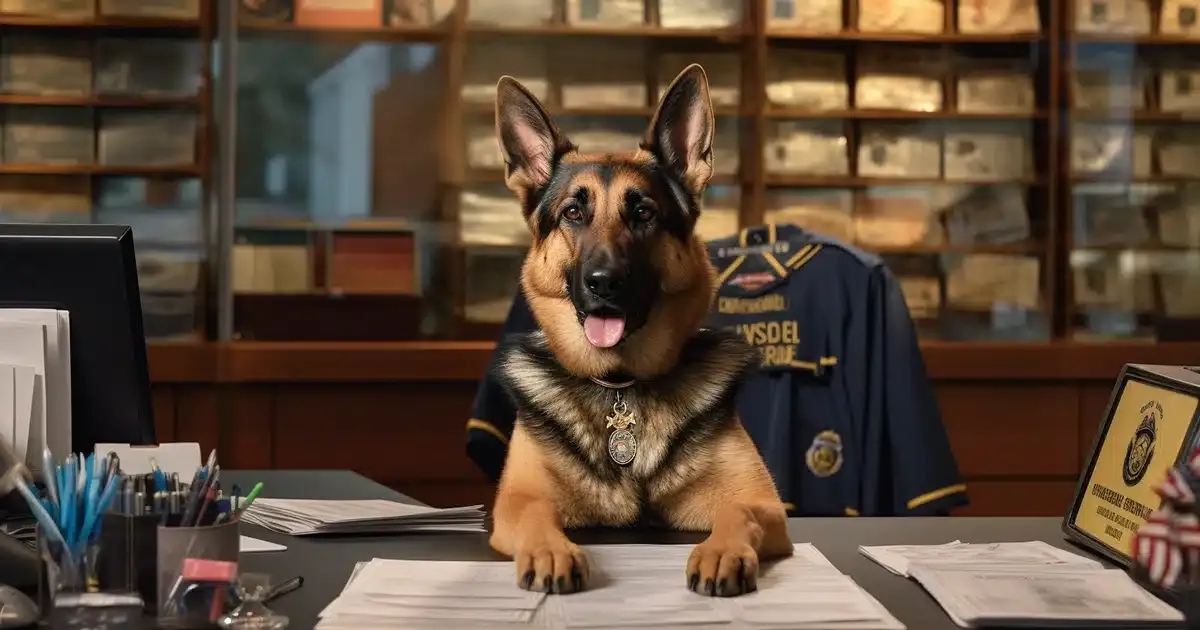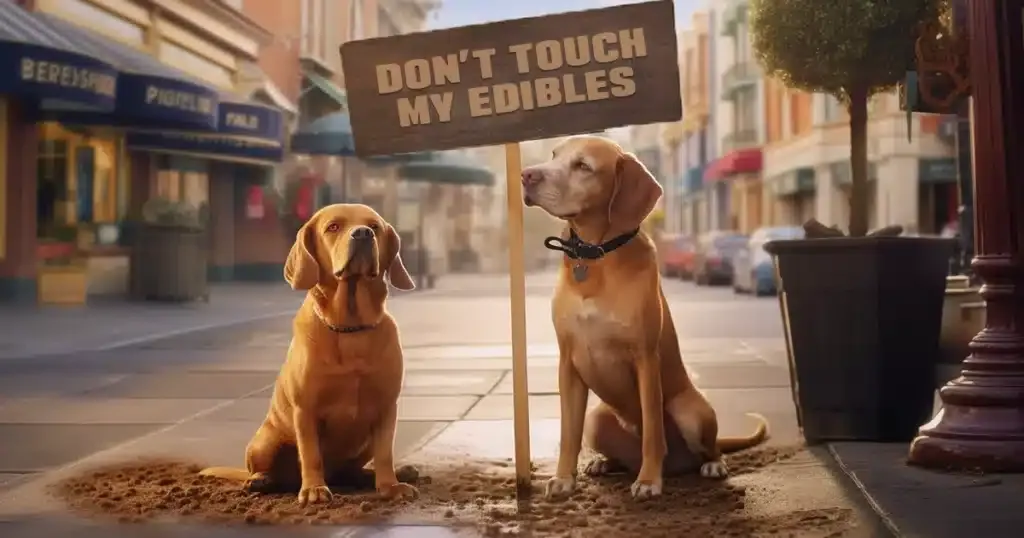Can Drug Dogs Smell Edibles?


Christopher Visser
Multi-Cannabis Business Owner
Christopher Visser, the Founder and CEO of Cannabidiol Life and THCGummies.com, is a distinguished figure in the CBD industry, recognized for his pioneering contributions since 2016. With over 120 published articles, Christopher has become a reputable cannabis researcher, writer, and author. He's built two prosperous cannabis ventures that collectively generated millions in annual sales. His in-depth analysis of numerous cannabis studies, collaboration with medical professionals, and personal engagement with thousands of customers underline his expertise and commitment to advancing cannabis understanding daily.
-
 Written By:
Christopher Visser
Written By:
Christopher Visser
- Published:
- Updated: February 8, 2024
- Too Quiet, Light Up The Convo!
In this exploration of a canine's ability to detect edible THC gummies, we dive deep into the world of edibles, understanding the uniqueness of their aroma, and whether or not police dogs can detect them.
We journey through the history and science of dogs detecting marijuana, the intricacies of dog drug sniffing training, and provide essential insights for those traveling with edibles by car or airplane.
Table of Contents
Have you ever found yourself wondering about the incredible capabilities of a dog’s nose, particularly when it comes to detecting the unique aroma of marijuana, cannabis edibles, and THC gummies?
If so, you’re in for a treat!
We’re about to embark on a fascinating journey, exploring everything from the power of a police dog’s sense of smell to the intriguing science and history behind dogs detecting marijuana. We’ll also dive into:
- the training of drug-sniffing dogs
- how different types of edibles fare against canine detection
- the current debates surrounding this topic
- essential tips for traveling with edibles
Before we begin, here are the most important questions and answers about a police dogs ability of smelling edibles.

FAQ
Can drug dogs smell edibles?
Yes, drug-sniffing police dogs can smell marijuana-infused edibles and THC gummies by detecting the aromatic terpenes found in cannabis plants and because a canine’s sense of smell is up to 100,000 times stronger than a human’s.
Can TSA detect THC gummies in luggage?
Airport scanners can detect food items, but they cannot determine if these are edibles. The suspicion level of airport security may depend on the packaging and smell of the edibles. In scanners, all organic materials, including edibles, appear the same.
Are Delta 8 gummies detectable by sniffer dogs?
It’s possible but unlikely. Drug-sniffing dogs are typically trained to detect cannabis through specific scents like caryophyllene oxide and beta-caryophyllene. Unless your delta 8 gummies contain these substances, it’s improbable dogs will detect them.
Which drugs can drug-sniffing dogs detect?
Drug-sniffing dogs can be trained to detect a variety of illicit substances. This can include marijuana, cocaine, heroin, methamphetamine, opiates, ecstasy, and LSD.
How do I mask the smell of edible gummies?
Using a robust body wash or shampoo can help mask the smell of edibles. Alternatively, a strong perfume can serve the purpose too. Just be careful to not overdo it as it may irritate those around you.
Can police dogs detect THC through vacuum-sealed bags?
Vacuum-sealed bags may not be completely scent-proof to a drug dog’s highly sensitive nose due to microscopic permeabilities. However, if a container was entirely non-porous and airtight, it would be more challenging for a dog to detect it.
Is it easy to conceal edibles?
Yes, edibles are relatively easy to conceal. For instance, gummy edibles can be put in an empty bag of regular gummy candies. Similarly, shatter and wax can be hidden in honey candy bags.
How can I prevent police dogs from finding my edibles?
The best way is to place edibles in a vacuum sealed bag that are then placed inside a water-tight and air-tight container. This concealment is deemed to be the most effective.
Do Delta 8 edibles emit a smell?
Pure Delta-8-THC doesn’t have a significant smell. However, Delta-8-THC products can vary in scent, ranging from fruity fragrances to oily aromas, and even the herbal scent of cannabis, depending on the product.
Is the smell of Delta-8 THC strong?
Delta 8 distillates can have a potent aroma, similar to other forms of concentrated cannabis. Some people describe this smell as “earthy.” When vaporized, these distillates produce a thick, white smoke with a strong odor.

The Remarkable Canine Nose: A Deep Dive into a Dog’s Sensory Perception
The canine nose is nothing short of remarkable. It’s your dog’s most powerful sense and it shapes how they interact with the world.
The Incredible Strength of a Dog’s Sense of Smell
Have you ever wondered how your dog knows you’re around the corner before you even make a sound? It’s all thanks to their incredible sense of smell. Here are some fun facts about your dog’s sniffing power:
- A dog’s sense of smell is estimated to be between 10,000 to 100,000 times more sensitive than ours. Imagine a scent being detectable to you at one mile. For a dog, that scent can be detected 100,000 miles away.
- The part of a dog’s brain that analyzes smells is, proportionally speaking, 40 times greater than ours.
- Dogs have about 300 million olfactory receptors in their noses, compared to about six million in humans.
Remember, dogs experience the world through their noses. So, let them have a good sniff on their walks. It’s like reading the daily news for them!

Tracking Down The History and Science of Canine Marijuana Detection
Unraveling the history and science of canine marijuana detection is like going on an exciting journey of discovery. You will be amazed at how this has evolved over time and the science behind it.
Historical Progression of Dogs Smelling Marijuana
Canines and humans have a bond that dates back thousands of years. Over time, we’ve trained dogs to help us with tasks, including detecting substances like marijuana. Here’s a snapshot of how this has evolved:
- Ancient times: Dogs were initially used for hunting, herding, and protection.
- Middle ages: Their roles expanded, with some breeds trained to retrieve game, pull sleds, or rescue people.
- Modern era: Dogs began to be used by law enforcement and military for various tasks, including drug detection.
It’s important to understand that drug-sniffing dogs are trained, not born. Which brings us to the science behind how they detect marijuana.
The Scientific Mechanism Behind Dogs Smelling Marijuana
How do dogs smell marijuana? Here’s the science:
- Dogs are trained to detect specific terpenes found in cannabis, primarily caryophyllene oxide. This is a byproduct of drying and curing marijuana and is not found in hemp in substantial quantities.
- When dogs ‘alert’ to the scent, they are actually detecting these terpenes, not THC, CBD, or any other cannabinoid.
- Each dog is trained to respond in a certain way when they detect this scent. It could be sitting down, barking, or scratching at the source.
It’s a fascinating world, isn’t it? So, the next time you see a police dog at the airport, you’ll know a bit more about the history and science behind their incredible skills.

Training Drug-Sniffing Dogs To Detect Edible Cannabis Products
The training of drug-sniffing dogs is an impressive process. It requires a lot of time, patience, and skill. But how does it work for detecting edible cannabis products? Let’s dive in.
The Training Process of Drug-Sniffing Dogs
The training process of drug-sniffing dogs is a systematic one. They’re trained to identify specific scents related to drugs, including marijuana. Here’s a simplified breakdown:
- Association: The dog is exposed to a toy that has the target scent. They play with this toy, developing a positive association.
- Search: The trainer hides the toy, and the dog is encouraged to find it using its nose.
- Alert: When the dog finds the toy, it’s trained to display a specific alert behavior. This could be sitting, barking, or scratching.
This process is repeated until the dog can reliably find the target scent and alert their handler.
Training Drug Dogs to Detect Marijuana Edibles
Training dogs to detect marijuana edibles is a bit more challenging. Why? Because the scent of cannabis is often masked by other ingredients in edibles. But it’s not impossible. Here’s how it works:
- The dog is trained to recognize the smell of certain terpenes found in cannabis.
- They’re then exposed to these scents in the context of different food items.
- Over time, the dogs learn to separate the smell of the cannabis from the smell of the food.
The Scope of a Drug Dog’s Training
The training of a drug dog doesn’t stop at marijuana and edibles. Here’s the other illegal substances they’re trained to detect:
- Other illicit drugs like cocaine, heroin, methamphetamine, and LSD.
- Currency, firearms, and explosives.
- Missing persons and cadavers.
As you can probably imagine, a well-trained drug dog is an enormous asset for drug enforcement agencies.

The Unique Aroma of Weed Edibles
Weed edibles AKA ‘WEEDIBLES’ have a unique aroma. The distinct scent of edibles comes from very specific, microscopic compounds naturally-found in cannabis plants called Terpenes.
Here’s a closer look:
- The scent of cannabis comes from compounds called terpenes.
- Different strains of cannabis have different terpenes, leading to different smells.
- When cannabis is used in edibles, the scent can be masked by other ingredients. However, the underlying terpene profile is still present, which is what drug dogs are trained to detect.
Remember, just because you can’t smell the cannabis in an edible, doesn’t mean a trained dog can’t. They’re a lot better at this game than we are!

Dogs’ Detection Capabilities for Various Types of Edibles
Dogs are amazing creatures with an astounding sense of smell. But how well can they detect different types of edibles? Let’s find out.
Marijuana Edibles and Canine Detection
Marijuana edibles come in many forms. Cookies, brownies, gummies – you name it. And dogs can be trained to sniff them out.
- They’re trained to detect specific terpenes, or aromatic compounds, found in cannabis.
- These terpenes are still present in edibles, even though the smell might be masked by other ingredients.
- So, if a dog is well-trained, it can potentially detect marijuana edibles.
Detecting Edible Weed
Detecting edible weed is an ability that dogs can develop with the right training. But it’s not always straightforward.
- The smell of weed in edibles can be masked by other ingredients.
- However, the underlying scent profile is still there.
- With rigorous training, dogs can learn to separate the smell of cannabis from the smell of the food.
Delta-8 Products and Canine Police Units
Given the differences in Delta-8 products, canine police units may face new challenges.
- Dogs are typically trained to detect specific scents, not specific substances.
- If a Delta-8 product has a different scent profile, a dog might not recognize it.
- Therefore, new training methods might be needed for canine units to effectively detect Delta-8 products.
Delta-8 Gummies
Delta-8 gummies are a newer product on the market. They’re similar to other cannabis edibles but contain a different type of THC.
- Delta-8 THC is chemically distinct from the Delta-9 THC found in most cannabis.
- This means that the terpene profile might be different.
- As a result, dogs trained to detect traditional marijuana might not be as effective at detecting Delta-8 gummies.

The Reliability and Debate Surrounding Canine Detection
Canine detection is a powerful tool, but it’s not without its debates and challenges. Let’s explore this further.
The Case for Police Dogs Smelling Edibles
There’s a strong case for police dogs being able to smell edibles.
- Dogs have an incredibly acute sense of smell, far superior to humans.
- They can be trained to detect specific scents, even when those scents are masked by other smells.
- This makes them potentially effective at detecting cannabis edibles.
The Reliability of Drug Dogs in Detecting Edible Marijuana
Despite the potential of canine detection, there are questions about its reliability.
- False positives can occur, especially in high-stress situations or if a dog is eager to please its handler.
- The presence of a scent doesn’t necessarily indicate the presence of an illicit substance. For example, a dog might alert to a bag that once contained marijuana, even if the bag is now empty.
- Finally, the ability of dogs to detect cannabis edibles specifically is still somewhat untested and uncertain.

Travel Guidelines for Carrying Edible Cannabis Products
Navigating the world of travel with edible cannabis products can be tricky. Rules vary widely, and enforcement can be unpredictable. Here’s what you need to know.
Crossing State Lines with Edible Cannabis Products
Traveling with cannabis edibles isn’t like traveling with a bag of chips. You need to be aware of several things.
- Marijuna-derived edibles are federally illegal, Hemp-derived edibles are federally legal.
- Laws vary by state. What’s legal in one state might not be legal in another.
- Even if cannabis is legal in both states, it’s illegal to cross state lines with it because federal law applies.
- Being unaware of the law isn’t a valid defense. Do your research before you travel.
Insights into Baggage Check Procedures
If you’re flying, you might wonder about the baggage check procedures.
- Both checked bags and carry-ons are subject to search.
- However, the TSA’s focus is on security, not drugs. Their main goal is to find explosives and weapons.
- If they stumble upon drugs, they typically refer the matter to local law enforcement.
Consequences of Finding Drugs in Checked Baggage
Finding drugs in checked baggage can lead to serious consequences.
- Law enforcement could be called.
- You could face criminal charges, depending on local laws.
- Even if you’re in a state where cannabis is legal, airports are federally regulated. This means federal laws apply.

Strategies for Concealing Edibles from Drug-Sniffing Dogs
Trying to conceal edibles from drug-sniffing dogs is risky business. It’s generally best to avoid it. However, understanding the challenges can be informative.
The Challenge of Hiding Delta-8 from Drug-Sniffing Dogs
Hiding Delta-8 products from drug-sniffing dogs presents unique challenges.
- Dogs are trained to detect specific scents.
- Masking the scent of a drug can be extremely difficult.
- The best strategy is to avoid traveling with substances that could get you into trouble.

The Role of Drug-Sniffing Dogs in Border Services
Drug-sniffing dogs play a crucial role in border services. Despite advances in technology, these four-legged officers continue to be an invaluable resource.
The Continued Use of Drug-Sniffing Dogs by Border Services
Despite technological advances, border services still employ drug-sniffing dogs.
- Dogs can often detect drugs more quickly and accurately than technological devices.
- They’re especially useful in large, crowded areas like border crossings.
- However, their use isn’t without controversy, especially when it comes to false positives.

Quick Wrap Up & Concluding Thoughts
The canine nose is a powerful tool, used extensively in law enforcement and border control to detect various substances, including cannabis-infused edibles.
Trained to detect specific cannabinoids and terpenes, drug dogs can often sniff out concealed substances even when masked by other ingredients. However, their ability to detect newer products like Delta-8 gummies seems to remain a challenge.
As you travel, it’s crucial to remember the laws and regulations surrounding marijuana edibles and hemp edibles, because you don’t want to be caught with edibles at the TSA scanning line.
The role of drug-sniffing dogs continues to be significant, but not as extreme in regards to edible cannabis products.
Now, over to you:
- How do you feel about drug-sniffing dogs used at airports and border crossings?
- Would you risk it?
- For kicks, what is the most-creative way you’ve hid your edibles?
Share your thoughts in the comments below!

If this article sparked a new insight, pass the flame…
LET’S IGNITE RIPPLES OF CANNABIS WISDOM.
Be the catalyst for someone’s breakthrough moment.
SHARE ON SOCIAL MEDIA

Looking For Something Else?



